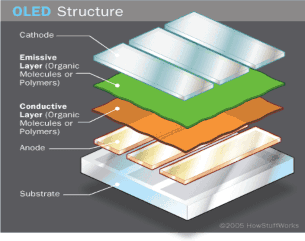39. OLED-
♤ An OLED (organic light-emitting diode) is a light-emitting diode (LED) in which the emissive electroluminescent layer is a film of organic compound which emits light in response to an electric current. This layer of organic semiconductor material is situated between two electrodes. Generally, at least one of these electrodes is transparent. OLEDs are used to create digital displays in devices such as television screens, computer monitors, portable systems such as mobile phones, handheld games consoles and PDAs.
♤ There are two main families of OLEDs: those based on small molecules and those employing polymers. Adding mobile ions to an OLED creates a light-emitting electrochemical cell or LEC, which has a slightly different mode of operation. OLED displays can use either passive-matrix (PMOLED) or active-matrix addressing schemes. Active-matrix OLEDs (AMOLED) require a thin-film transistor backplane to switch each individual pixel on or off, but allow for higher resolution and larger display sizes.
♤ An OLED display works without a backlight. Thus, it can display deep black levels and can be thinner and lighter than a liquid crystal display (LCD). In low ambient light conditions such as a dark room an OLED screen can achieve a higher contrast ratio than an LCD, whether the LCD uses cold cathode fluorescent lamps or LED backlight. Due to its low thermal conductivity, an OLED typically emits less light per area than an inorganic LED.
♤ In simple terms, OLED is a whole new large-screen technology. The flat panel is made up of millions of tiny LEDs. The “O” in OLED stands for “organic” which means there is carbon within the molecules of the emissive (light producing) layer of the panel. Large-screen OLED panels need no lamps -- they are self illuminating. OLED HDTVs can be thinner and lighter than the skinniest LED LCDs, and have several other advantages over LCD TVs, regardless of whether the LCD is lit by LED or CCFL.
♤ For instance, they provide very wide and consistent color no matter where you are seated in the room. LED LCDs tend to get significantly dimmer as you move away from the centre, and many exhibit color shift.


